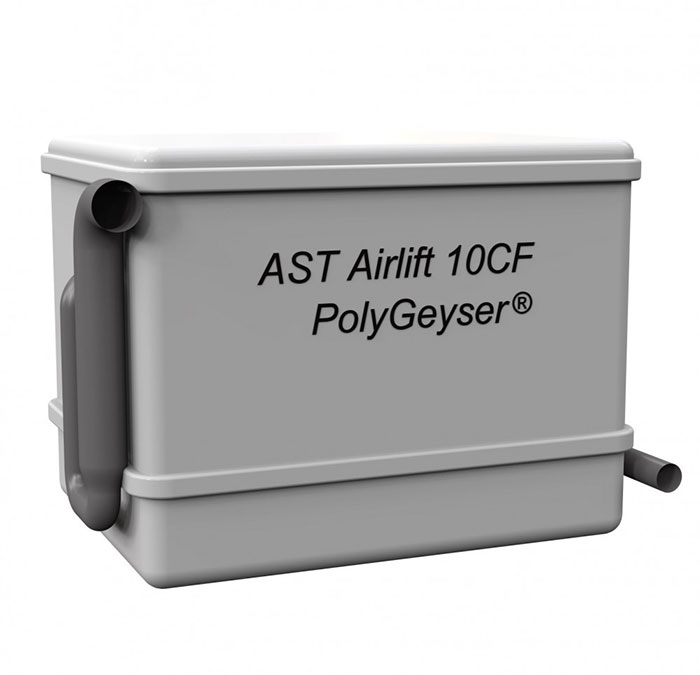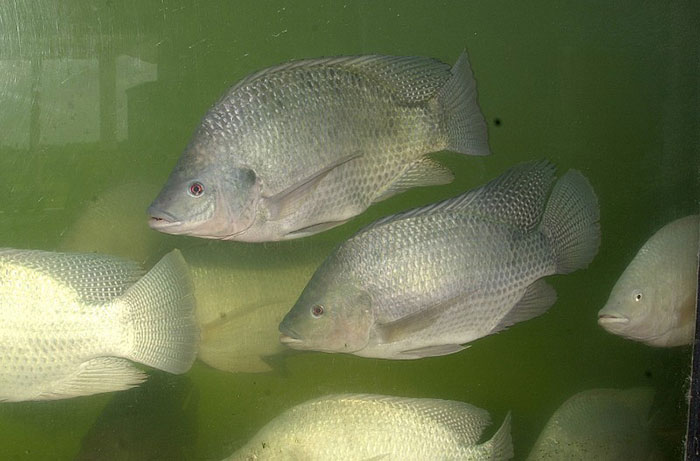
The airlifted filter configuration moves water using an air blower instead of a standard water pump, lowering power consumption and avoiding the need for expensive, mechanical equipment. Are you more interested in a standard water pump configuration? These filtration systems can move water via pump or airlift; the versatility of our Airlift filters create a customizable solution to fit your own needs.
The new AST Airlift is ideal for aquatic tanks ranging in size between 2,000 and 4,000 gallons. Do you need a filter that can withstand the heavy loading of a large commercial operation? These filtration products are the ultimate choice for you. Are you looking for an airlift system for a tank larger than 4,000 gallons? Be sure to contact a filtration engineer today so we can discuss your specific needs!
The AST Airlift™ is made out of fiberglass for long lasting, durable filtration. Manufactured and assembled in the United States, these units are thoroughly tested at the AST lab before being shipped to ensure maximum reliability and quality.

Like all of AST's bead filters, AST Airlift filters provide both mechanical and biological filtration in one, single unit. Thanks to patented Polygeyser® technology, these filters offer automatic backwashing that minimizes water loss by removing ONLY concentrated solids (sludge).
| Model | Media Volume (cubic feet) | Surface Area (square feet) | Flow Rates (gpm) | Feed Rate (lbs/day) | Lbs of Fish Supported | Recommended Culture Volume (gallons) |
|---|---|---|---|---|---|---|
| AST Airlift 10 CF | 10 | 4000 | 100-150 | 10-15 | 1000-1500 | 2000-4000 |
Our patented PolyGeyser® technology separates the backwash process from water loss. In most filtration systems, solids are purged from the system by draining the dirty water after the backwash sequence. The AST Airlift™ separates the solids into a sludge chamber, where other solids can continue to collect until the sludge is manually drained. Exclusively draining concentrated sludge minimizes water loss.
The PolyGeyser® filter is a breakthrough in filter technology. It is very different from most filters on the market due to its automatic pneumatic backwash mechanism. Water enters below the bed of enhanced nitrification media and travels upward through the filtration chamber where mechanical and biological filtration take place. Simultaneously, air is introduced into the charge chamber at a constant predetermined rate to achieve the desired backwash frequency.
Once the charge chamber has reached capacity, the pneumatic trigger fires, releasing the entrained air from the charge chamber below the bead bed. The sudden release of air from the charge chamber causes the beads to mix as the air agitates the beads. As the beads drop, the bead bed expands downward while simultaneously water rushes downward through the expanded beads, sweeping the solids away and into the air charge chamber.
In the chamber, the solids settle out from the backwash waters and are later removed from the filter. PolyGeyser® filters recycle the backwash water while concentrating the waste products so that you have extremely low water loss while maximizing the nitrification capacity.
Frequent backwashing has proven advantageous for optimizing the nitrification capacity. Numerous gentle scrubbing cycles promotes a higher rate of nitrification by maintaining a healthy thin biofilm on the surface of the bead media. Typical backwash cycles occur every 3-6 hours.
Keep the correct water level for optimum filter performance. The water level should run at the diameter of the return pipe. This is half of the pipe's return height, leaving plenty of room for air to push the water along.
These Polygeyser® filters will backwash themselves so you do not need to manually initiate backwashes on a regular basis. You will need to adjust the air using your suflow air gauge, so that your unit regularly backwashes four to six times a day. If you notice your filter is not backwashing as vigorously as it has been previously, running the air on high will force the unit to backwash a few times to dislodge stubborn deposits. Be aware that the water will become temporarily cloudy from fine solids. Then reset the air gauge to the typical four to six backwashes a day and normal operation will take care of the rest
These units are different from many filters on the market, and special care needs to be taken when draining these filters due to the unique auto-backwashing mechanisms.
If your filter is utilizing the auto-purge features, there different methodologies for setting the amount of sludge to be removed. You can adjust air flow remove more or less sludge.
For mineralization, consider letting more sludge pile up within the sludge chamber for digestion. This can help increase available nitrates for plant culture. Test the water quality to ensure the water remains suitable for the fish. More frequent water changes may be needed, or more frequent backwashes to remove excess solids. Running at a lower air pressure will keep the system from purging larger solids from the system.
For fish culture exclusively, purge sludge preemptively to prevent declines in water quality. Set your unit to remove larger amounts to lower the amount of waste breaking down in the system. Adjusting for more powerful airflow will result in a stronger current that will lift more sludge and waste out of the filter. This filter will also backwash more frequently when being operated in this manner.
The AST Airlift filter is fully plumbed with pipes configured for airlifted water circulation inside it. The water can be airlifted or pumped out depending on your situation.
The air pump needs to be placed on location, and air lines ran to the air inlet points on the filter. An air check valve should be installed to keep water reaching the air pump or the air pump can be located above the water level on a high shelf so that water cannot reach it. If water gets to the air pump, it can burn out the pump or cause a dangerous electrical situation.
Once the air has been hooked up, fill the tank with water and make sure the water is circulating between the filter and the tank. The tank inlet pipe should have a continuous stream of water and not gurgle. The ideal water level is at half the height of the tank inlet pipe.